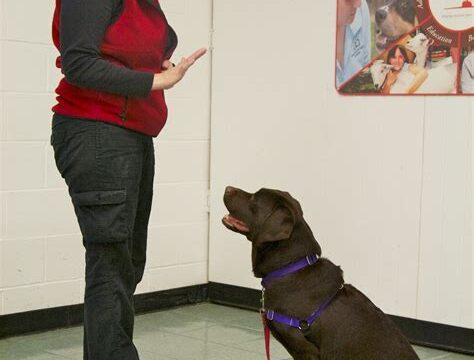Explore accredited dog training schools and compare curriculum, costs, and alumni success stories for a comprehensive evaluation. Find practical experience opportunities and financial aid options. Visit potential academies.
Understanding Different Training Methods
In the world of dog training, there are various methods that trainers use to teach and modify behavior. It’s important to understand the different training methods so that you can choose the right approach for your dog. One of the most popular methods is positive reinforcement, which involves rewarding good behavior with treats or praise. This method focuses on building a strong bond between the trainer and the dog, and is often used for basic obedience training. On the other hand, there is also the traditional method of training, which involves using corrections and punishment to discourage unwanted behavior. This method may be effective for certain dogs, but it’s important to use it carefully and with the guidance of a professional trainer.
Another training method is clicker training, which involves using a small clicker device to mark desired behavior and then providing a reward. This method can be very effective for teaching new behaviors and tricks. Additionally, there is the dominance-based training method, which focuses on establishing the trainer as the pack leader. This method may not be suitable for all dogs, and can sometimes lead to aggression or fear-based behavior.
It’s important to research and understand the different training methods before enrolling in a dog training academy, as each method has its own principles and techniques. By understanding the different training methods, you can choose an academy that aligns with your own training philosophy and goals for working with dogs.
Researching Accredited Dog Training Schools
When it comes to pursuing a career in dog training, one of the most important steps is to thoroughly research accredited dog training schools. Accreditation is crucial in ensuring that the school meets certain quality standards and that your education will be recognized by employers and certification bodies. Start by researching different accrediting bodies in the field of dog training and look for schools that are accredited by reputable organizations such as the Certification Council for Professional Dog Trainers (CCPDT) or the International Association of Canine Professionals (IACP).
Once you have compiled a list of accredited dog training schools, take the time to thoroughly examine and compare their curriculum and course offerings. Look for programs that cover a wide range of topics including canine behavior, training techniques, communication skills, and more. Consider the practical training opportunities provided by each school, such as internships, externships, or hands-on training with real dogs. These experiences are invaluable in gaining practical skills and building a strong foundation in dog training.
Another important factor to consider when researching accredited dog training schools is the cost and financial aid options available. Compare the tuition fees of each program and inquire about scholarship opportunities, grants, or student loans. Additionally, explore alumni success stories and testimonials to get a sense of the school’s track record in producing successful and skilled dog trainers. Visiting and touring potential dog training academies can also provide valuable insights into the learning environment, facilities, and teaching methodologies.
Evaluating Curriculum and Course Offerings
When considering which dog training academy to attend, it’s important to thoroughly evaluate the curriculum and course offerings. Curriculum plays a crucial role in shaping your education and preparing you for a successful career in dog training. Be sure to research the specific courses and topics covered in the program to ensure they align with your career goals and interests.
Additionally, it’s essential to assess the course offerings in terms of flexibility and variety. Look for academies that provide a range of courses, including both foundational and advanced topics, as well as specialized training methods and techniques. This will allow you to tailor your education to suit your interests and develop a well-rounded skillset.
Ultimately, the curriculum and course offerings of a dog training academy are key factors in choosing the right education for your career. By thoroughly evaluating these aspects, you can ensure that you receive a comprehensive and tailored training experience that will set you up for success in the field of dog training.
Considering Practical Experience Opportunities
When choosing the right dog training academy for your education, it is important to consider practical experience opportunities. Practical experience is crucial for gaining hands-on skills and real-world knowledge in the field of dog training. Look for training schools that offer practical experience opportunities such as internships, externships, or volunteer programs with reputable dog training organizations or facilities. These opportunities will allow you to apply the theoretical knowledge you learn in the classroom to actual training scenarios with dogs, and gain valuable practical experience under the guidance of experienced professionals.
Practical experience opportunities also provide you with the chance to observe and interact with a variety of dog breeds, personalities, and behavior issues, which can further broaden your understanding and skill set as a future dog trainer. Additionally, participating in practical experience opportunities allows you to build a network of contacts within the dog training industry, which can be beneficial for future career opportunities and mentorship.
Furthermore, practical experience opportunities can also help you determine which specific areas of dog training you are most interested in or passionate about, whether it’s obedience training, behavior modification, agility training, therapy dog training, or any other specialized area. This self-discovery can guide your career path and education choices, helping you focus on the areas of dog training that align with your strengths and interests.
Comparing Costs and Financial Aid Options
When choosing the right dog training academy for your education, one important factor to consider is the cost of the program. Researching and comparing the costs of different dog training schools can help you find a program that fits your budget. Additionally, it’s important to explore the financial aid options available at each school, including scholarships, grants, and student loans.
Comparing the costs and financial aid options can help you make an informed decision about which dog training academy is the best fit for your financial situation. It’s important to weigh the potential financial burden of attending a particular program against the potential return on investment in terms of your future dog training career.
By carefully evaluating the costs and financial aid options at different dog training academies, you can make a well-informed decision that will set you up for success in your future career as a professional dog trainer.
Exploring Alumni Success Stories and Testimonials
When researching dog training schools, it’s important to explore alumni success stories and testimonials to understand the impact of the education they received. These stories can provide valuable insights into the quality of education and the practical experience opportunities offered by a particular academy. By hearing from graduates who have pursued careers in dog training, prospective students can gain a better understanding of the skills and knowledge they can expect to acquire.
Reading alumni success stories and testimonials can also provide a glimpse into the potential career paths and opportunities available in the field of dog training. Aspiring trainers can learn about the different areas of specialization that alumni have pursued, as well as the successes and challenges they have encountered in their careers. This information can help prospective students envision their own futures in the industry and set realistic expectations for their education and career goals.
Furthermore, exploring alumni success stories and testimonials can offer valuable insights into the support and resources provided by the dog training academy. Graduates may share their experiences with faculty, staff, and fellow students, shedding light on the community and network that students can expect to be a part of. This can be especially helpful for individuals who value a supportive and collaborative learning environment as they consider their options for dog training education.
Visiting and Touring Potential Dog Training Academies
When it comes to choosing the right dog training academy for your education, one important step is to physically visit and tour the potential academies. This allows you to get a firsthand look at the facilities, meet with the instructors, and get a feel for the overall environment of the academy. Visiting the academies in person can give you a much better sense of whether or not it is the right fit for you and your educational goals.
During your visits, take note of the cleanliness and organization of the facilities. A well-kept and organized academy can be a good indication of the level of professionalism and care that the instructors and staff have for the students and their education. Additionally, pay attention to the resources and equipment available for students to use during their training. A well-equipped academy can provide a more comprehensive and hands-on learning experience.
Meeting with the instructors and staff during your visits is also important. This allows you to ask any questions you may have about the curriculum, training methods, and any additional support or resources that may be available to students. It also gives you the opportunity to gauge the level of knowledge and experience that the instructors have, as well as their approach to teaching and working with students. Overall, visiting and touring potential dog training academies can give you valuable insights and help you make an informed decision about where to pursue your education.
Frequently Asked Questions
What should I consider when choosing a dog training academy?
You should consider the type of training methods used, the credentials of the trainers, the facility and equipment, and the specific programs offered.
Are there different types of dog training methods?
Yes, there are various methods such as positive reinforcement, clicker training, electronic training, and relationship-based training.
How can I ensure the trainers at the academy are qualified?
You can ask about their certifications, experience, and success stories with past clients.
What should I look for in the facility and equipment at a dog training academy?
You should look for a clean, safe, and well-equipped facility with tools like agility equipment, leash walking tools, and obedience training aids.
What are some common programs offered at dog training academies?
Common programs include basic obedience training, behavioral problem-solving, agility training, and therapy dog training.
How important is it to visit the dog training academy before enrolling?
It is very important to visit the academy to observe the training in action, meet the trainers, and assess the environment for your dog’s comfort.
What role does the dog owner play in the training process?
Dog owners play a crucial role in reinforcing the training at home, maintaining consistency, and building a strong bond with their dog.





